Free shipping for all orders over 30 euros!
-
Shop
- Insights
-
About ROMBO
- Dealers
- Guitar Pick finder
- Gift Card
+Categories
- accessories
- bass
- bass pick
- bass picks
- bass plectrum
- bass plectrums
- beginner
- bright tone
- chose guitar pick
- chose guitar picks
- chose plectrum
- chose plectrums
- CrystalBright
- Diamond
- Diamond pick
- discipline and guitar
- DIY generation
- durability pick
- durable pick
- eco
- ecoblack
- find guitar pick
- find plectrum
- fingers vs picks
- grip
- grip guitar pick
- guitar accessories
- guitar advantages
- guitar benefits
- guitar career
- guitar health
- guitar injury
- guitar learn
- guitar lesions
- guitar lesson
- guitar method
- guitar noise
- Guitar noise plectrum
- guitar pain
- guitar pick
- guitar pick beginner
- guitar pick bevel
- guitar pick buy
- Guitar pick diamond
- guitar pick durability
- guitar pick durable
- guitar pick eco
- guitar pick features
- guitar pick grip
- guitar pick material
- Guitar Pick Noise
- Guitar Pick online
- guitar pick recycled
- guitar pick recycled material
- guitar pick special features
- guitar pick textures
- guitar pick thickness
- guitar pick variable thickness
- guitar picks
- guitar tone
- guitar warm-up
- guitarpick
- guitarpicks
- hold a guitar pick
- hold guitar pick
- hold guitar picks
- hold pick
- hold plectrum
- hold plectrums
- how to
- how to chose your guitar picks
- jazziii
- learn guitar
- lose guitar pick
- material
- materials
- mental health and guitar
- motivation and guitar
- music
- not to lose guitar pick
- Online guitar
- online guitar pick
- online guitar pick buy
- pick
- pick durability
- pick material
- pick noise
- Picks
- picks vs. fingers
- play bass fingers
- play bass picks
- play bass with fingers
- play bass with pick
- play bass with picks
- play bass with plectrum
- play guitar faster
- plectrum
- plectrum attributes
- plectrum beginner
- plectrum bevel
- plectrum characteristics
- plectrum features
- plectrum grip
- plectrum material
- plectrum noise
- plectrum recycled
- plectrum shape
- plectrum variable thickness
- plectrums
- Plek
- pua
- recycled
- recycled guita pick material
- recycled guitar picks
- recycled picks
- recycled plectrum
- Rombo Diamond
- rombopicks
- tendonitis guitar
- the guitar pick
- tone
- variable thickness
- warm tone
- warm-up guitar

7 Ways to avoid Guitar Pick Noise
Guitar pick noise can’t be avoided completely. Especially while recording acoustic guitar, plectrums tend to create a lot of click and clack sounds and noises that can ruin your playing experience as well as your listeners’.
As you learn how to play the guitar better, you will reach a point where you want to focus on transmitting emotion, playing with impact, and enhanced dynamic control.
In order to master your guitar techniques, you must have total control of every sound produced by your guitar; intended and unintended.

Personally, I think pick noise is a part of the guitar playing, and I even enjoy some vintage recordings where the guitar pick noise seems to be present almost on purpose. However, for most of the occasions, you want to eliminate it.
We have summarized all the tips and tricks we think can help you reduce the noise when playing with a guitar pick. Enjoy it!
1- Hold your guitar pick with less tension
Guitar picks create noise when plucking your strings. Holding your guitar pick more loosely will help a lot, since your fingers absorb some of the energy when the pick hits the strings.
We have published an article called “How to hold a guitar pick”, which contains everything you need to know to master this trick.

If you are recording your tracks, one thing that can help is to add some more volume to your instrument in relation to the others. This is a common method used in studios that helps the guitar players to relax.
Whether you are planning a studio session, a jam with your friends, or some solo relax sessions at home, a conscious warm-up before playing guitar is mandatory.

2- Try different angles when plucking your string
The angle of the guitar pick in relation to the strings is the most discussed element when it comes to guitar pick noise.
Basically, the less pick is in contact with your guitar strings, the less noise it produces. Angle the pick slightly to the strings.
Try different angles when plucking your string. This will require a conscious adjustment from your side, but once mastered will allow you to vary the attack of the pick more easily.
Depending on the guitar pick you are using, the music style and guitar techniques you use, and your skill level, you will need a different attack angle, so focus 30 minutes on trying to find the best one for you and get used to playing this way.
3- Is your picking force adequate?
Sometimes you are playing and the flow starts, you mentally leave the room and enter “the zone”, that beautiful place where you sound better than usual.
We get so much into the music, that we just naturally pick harder.

Excessive picking force is one of the most common causes of guitar pick noise. In addition, it can choke out the sustain and cause the notes you are playing to decay in a much less natural way.
4- Nylon guitar picks are less noisy
The material of the guitar picks not only affects the tone, but also the noise the plectrum creates.
Nylon is considered to be one of the least noisy formulas when it comes to industrial materials used for guitar picks.
This is due to the toughness of this compound, which thanks to its mechanical properties, is able to absorb heavy impacts efficiently.

At Rombo, we are using a modified version of nylon, which adds some extra durability and prolongs the lifespan of the guitar picks. This was necessary since nylon guitar picks wear down very quickly. You can learn more about the materials here.
If you are not sure if you are using the right guitar pick, a good option is a variety pack, which contains guitar picks with different attributes. This is a good way to test several picks and track your development as you start increasing your skill for each one.
The right guitar pick thickness
As a rule of thumb, you can estimate that heavier picks will be less noisy, which sounds kind of contradictory. But, why is that?

Using very thin picks in combination with fast-playing, like strumming, will cause the picks to bend as they leave the guitar strings, creating a kind of click noise. This happens especially when playing acoustic guitar, since the body of the guitar will act as an amplifier for that sound.
Heavier picks will let each string make its own noise without much unwanted accompaniment.

The variable thickness, included in all our guitar picks, not only improves the control but also reduces the noise. The body of the plectrum is thicker and stiff, while the tip is thinner and more flexible. With this feature, the overall flexibility of the tip is reduced while conserving its original thickness and material. This means more control and less noise.
Thick vs. thin guitar picks. In this article, we discuss all the aspects that make a difference.
A beveled edge can help you reducing the pick noise
Guitar picks with a beveled edge will slide better and cause less noise. In combination with the angle of attack we already mentioned, they can help you reduce the pick noise a lot.
Also, the shape and size of the pick are important, but this is more a matter of preference.

Reduce pick noise with a polished tip guitar pick
We have frequently discussed the impact a polished tip has on the tone and durability of a guitar pick.
A polished tip also slides quite easily over the edge of the guitar string. On the other hand, guitar picks with a rougher texture on the tip, will produce more treble response even when played on the edge. This also happens when the picks start to wear down.

However, as mentioned at the beginning of the article, some purist guitarists even prefer the pick to create noises and they included it extra in their recordings.
Bonus: Record yourself
Very experienced live players that don’t have much studio experience sometimes do not reflect enough on all the little nuances on their playing.

A good exercise to avoid this is to record yourself. It is amazing how much we miss when we get into the zone. You will notice pick noise when listening to your tracks and it is much easier to identify critical areas than while you are playing.
If you play acoustic guitar, try to locate the microphone(s) in different locations, you will discover how much of a difference it can make in terms of guitar pick noise.
Conclusion
We can’t eliminate pick noise completely, but there is enough to do to improve our playing and reduce it substantially.
The best way to reduce pick noise is to be aware of it and reflect on your playing to improve your skills and try different picks for different styles and guitar types.
If you discover a new way to reduce the pick noise, please let us know so we can include it in the article!

Inside Rombo Guitar Picks: Guitar Picks developed and engineered in Germany
This article was created because you asked for it. It is meant to be as transparent as possible, so that you can see who the faces behind Rombo are and how we organize this project internally.
We hope you enjoy it!
Rombo Guitar Picks: Short Introduction
Since 2019, Rombo has been researching surface finish and design in order to find the perfect balance between grip, ergonomics, and function in guitar picks and other guitar accessories. Rombo was born thanks to an amazing guitar player community whose aim is to continue this adventure and quest for the perfect guitar accessories.
Who are the faces behind Rombo Guitar Picks?
We are Judith and Carlos, a happily married couple trying to innovate in the world of guitar picks. We live near Stuttgart, Germany.

We both love music, guitars, product development, challenges, and attention to detail, so Rombo was the perfect excuse to mix all these things together and have some amazing adventures.
Our location in Remseck a.N., Germany
Packing and shipping of our guitar picks
From Remseck, near Stuttgart in Germany, we do almost everything.
Here, we receive the packaging and the dots we use to fix the guitar picks to the packaging. We try to be very organized and keep the place very tidy. Tidy places also look better for photographs!

In the shipping station, there is one tray for every guitar pick model. We also include a flyer and a “thank you”-card with every delivery. This way we make the experience more personal, while sharing our journey of packing your guitar picks directly with you!

We have a label printer, which is super useful, and thankfully our web system allows us to automate the printing for every customer and create a label with just one click.
Our post carrier receives the boxes from us with all the information they need to bring our products to you, including weight, countries, and import information for the customs.

We ship every order directly from our location.
The envelopes we use are not very cheap, but they protect the product well, they are made of 100% recycled paper and they are plastic free.

Always learning something new
We have to be very multifaceted to cover all the tasks we do, from idea generation, product development, graphic design, photography, web maintenance, logistics, social media, packaging development, and accounting, to all the stuff a start-up involves.

We believe that doing everything by ourselves gives us a very close perspective from the customer side.
This means, when you ask something on Instagram or Facebook, you receive an e-mail from us, or we answer your comment. It is us behind the screen typing every word and every smiley!

We love walking a lot. We go for a walk for 5 kilometres almost everyday. Almost every idea we applied to Rombo was created while having a walk. We called it our daily inspiration walk.

Rombo is a long journey
Two years ago, at the very beginning of this journey, we could not have imagined how many things we needed to learn!
We have encountered many challenges on the way; for example, I remember it was very difficult to find out how to sell internationally and establish a system that is fast enough for us.

I cannot tell how many books on startups, online marketing, Kickstarter or time management we have read! One of the most useful ones was A Crowdfunder's Strategy Guide: Build a Better Business by Building Community, by Jamey Stegmeier.
A funny anecdote is that Judith and I don’t have our own Instagram profiles. For the first post from Rombo, we had to check out a tutorial on Youtube to try to understand the process. I am glad to say that two years later, we have reached almost 20K followers!
PS: We still don’t have our own accounts, the one for Rombo is enough work! :)
Guitar picks: All about the design process
The most complex part is the design process of a guitar pick.
I like to sketch a lot, so I have lots of old ideas and sketches which I use as an inspiration source. Sometimes, we use questions to challenge the design process, like “Is it possible to create a guitar pick that is flexible and rigid at the same time?” While trying to answer this question, we came up with the idea of “variable thickness”, which has proven to substantially increase ergonomics.

Since we have an engineering & design background, we also do the modeling in 3D and product engineering. Every detail is important here to create high-quality products.

When we think the design is ready, we create some prototypes and send them to the testers. If you follow us on social media you will know some of the testers from our stories.
In total, we have about 30 guitar players that help us during this phase of the project and communicate with us which points they liked or didn’t like. Thanks to their feedback, we are able to improve areas of the guitar picks which we would otherwise not have thought of.
Manufacturing technologies
For the manufacturing of our guitar picks on a large scale, we use a technology called injection molding.

In this process, the melted raw material is injected into a mold with the negative shape of the guitar picks.
It is a very complex process with lots of engineering in it, the material has to be treated in a special way to keep the proper humidity, temperature and pressure, and to avoid external contaminations.

On the left, the injection mould from Rombo Diamond: Our polimer flows through the mould runner (yellow arrows) after it reaches over 270°C degrees and it is pushed forward.
The red area is the area we use for the grip texture. The blue area is high mirror polished.
On the right: The first ever produced Rombo Origami from 30.11.2018. The first 50 guitar picks we produced were sent to guitar pick testers who gave us feedback about the material, the grip, the tone and the shape.
The raw material we use is produced in Italy. We have worked very closely with our material partner to accomplish every requirement we had, including the 100% recycled material of the EcoBlack sets. If you want to know more about the materials we are using, you can find more information HERE.

Packaging for guitar picks
We believe packaging is a very important aspect of a product. We not only use it to create an atmosphere and emphasize the quality of the product, but also to inform you about the attributes of our guitar picks.

This is the reason we created packaging with lots of printable areas to describe the guitar picks. We include our parameter bars, a short description of the guitar pick, the 6 special attributes of a Rombo guitar pick, and a QR-code with extra information.
We had a total of about 6 different concepts before we decided which one was the most suitable.
Right now, we are creating the packaging layouts for the new models that will launch in 2021. We have received some samples and they look great!


If you want to see the new models, you can click HERE.
Guitar picks and social media:
Rombo product photography:
Carlos takes the pictures for social media. We are not very skilled with the camera, but we have learned a couple of tricks and after thousands of trials, we are able to take decent pictures in our living room.

In our Instagram you can find the best pictures.
Educating the customer
You have probably noticed that our posts on Instagram are mainly informative. Guitar picks are often underrated and most guitar players don’t think much about it.
However, guitar picks are the loudest amplifier you can have in your hands and are the bridge between you and your guitar.

We try to pass the know-how we have obtained directly to you, so you can make conscious decisions about the products you purchase. Aspects like the variations on the tone depending on guitar pick thickness, or why are there so many guitar pick shapes and materials… And this is the reason we created our blog articles.
Our aim is to create a communication process that goes back and forth between us. Some of you have become friends of ours and have won a new perspective of thinking about guitar picks.
Engagement of the community
“To listen closely and reply well is the highest perfection we are able to attain in the art of conversation.” – François de La Rochefoucauld, essayist.
We believe we have one of the most engaged communities ever! We try to answer every comment and every private message, and we are sure we have an answer rate very close to 100%.
You all have participated in surveys, and you have left amazing comments and reviews. You post stories regularly and we have had very deep conversations with some of you! Thank you!
We also received great support from many amazing blogs like Heavy Repping, Gigs and Guitars, The Gadget Flow, Ultimate-Guitar, Guitar World, and others.
Rombo around the world
Rombo is expanding. We are working with dealers around the world and currently we have sellers in the following countries:

This means, with the help of our dealers we are able to sell in Europe, North America, Asia, Australia, almost every country of South America, and South Africa.
Transparent communication with our dealers is a priority with us, and so far 100% of the new sellers stay with us! Together we are developing the brand and taking it to the next step.
The future of rombo:
During our inspiration walks, we talk about Rombo in the next few years. It is very difficult to imagine what the future will bring.
We would like to bring new designs (lots of them!), to increase the amount of recycled material for the manufacturing of the picks, or even be able to create colored recycled guitar picks. We want to talk more to our customers and share our experiences, and from time to time, share some great music and playlists.
We are only two people and every step takes its time. Some of you have written beautiful thank you letters to us or left very good reviews and we want to let you know that we are working hard everyday not to disappoint you :)
You are the best and you have a vote on the future of Rombo!

Guitar Pick Durability: Everything You Need To Know
The guitar pick has been in constant evolution since the 1920s.
Today, 100 years later, we have achieved great accomplishments in the area of durability of this very important piece of guitar gear.
In this article, we will review all the important points that can cause picks to wear out, and summarize all you need to know about guitar pick durability.
We will make some comments on the tone, to help control the changes, which happen after a guitar pick has worn down.
In addition, we will give some advice to keep your picks “healthier“, longer than expected.
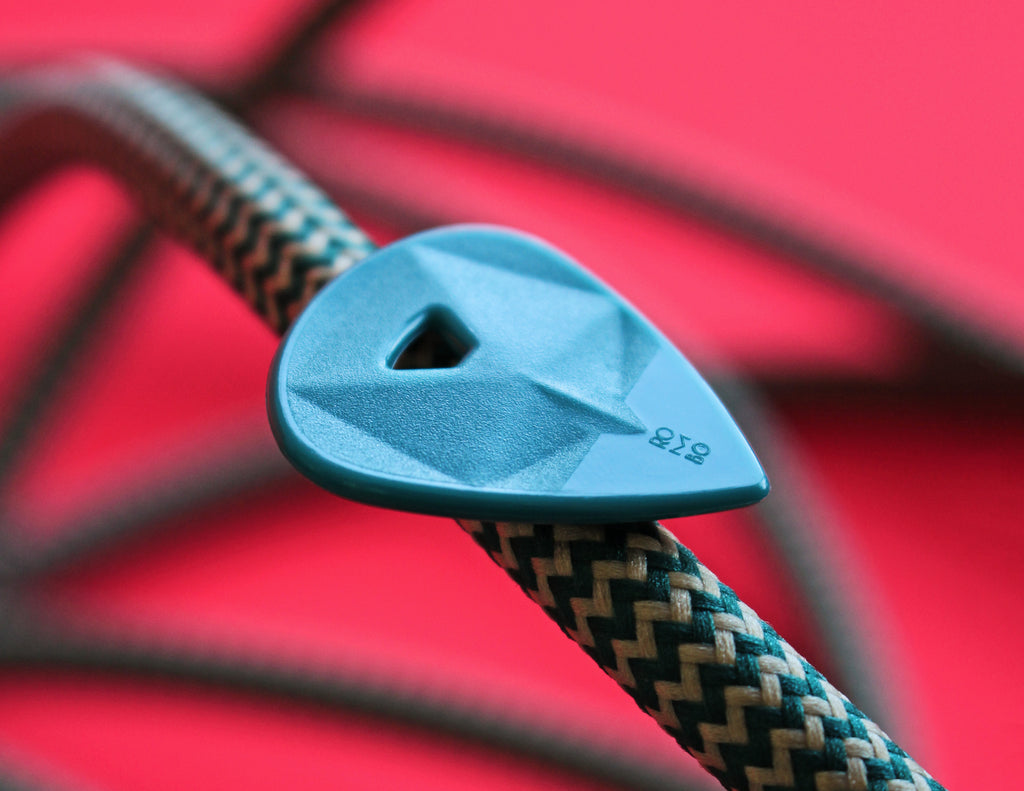
New vs. Old (worn down) Guitar Picks: Tone Changes
We all know that using different guitar picks, will also make a difference in your tone, and your playing. Material, shape, thickness and shape of the pick, directly affect the tone and playability.
Most standard plectrums can resist heavy strumming for a long time, without much wear and tear.
The first thing you may notice after using a guitar pick for some weeks, is that the tip is not as pointy as the new guitar pick. You will see it, and you will hear it, because the tone of the pick will change over time, with wear.


The rounded shape of the worn down plectrum, will create warmer tones, and feel darker. This is totally fine, if this is the tone you are looking for.
It will also affect the way your plectrum plucks the strings:

Just like the guitar strings, the frets, & other components, the guitar picks will wear out over time.
Some players feel a lack of control after the guitar pick has worn down, while others use the rounder picks because of the tone they produce. This especially happens to jazz guitarists, who tend to choose picks that are almost circular, for example: Rombo Waves.
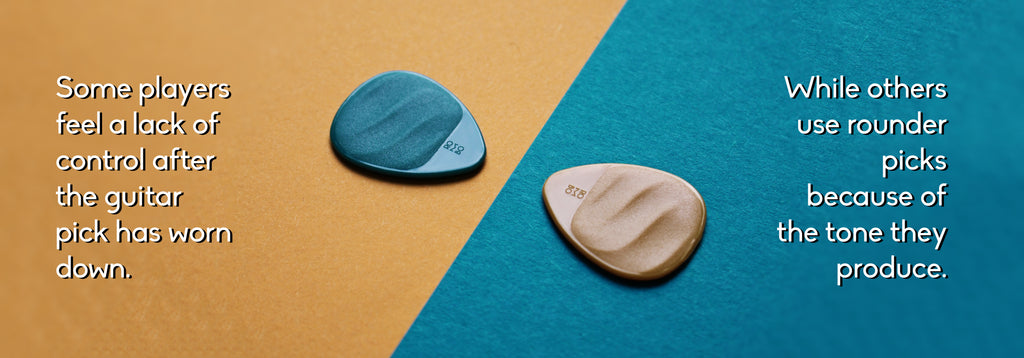
Gaining control when using rounder guitar picks, is an ability you can train yourself to do, and improve.
Why Can’t Picks Last Forever?
Guitar strings are usually made from a mix of steel, nickel, bronze, or brass. In other words: Metals.
Since most players use some kind of plastic material for their guitar picks, (nylon, delrin, …), it’s not surprising that friction between strings and picks will cause the guitar picks to wear down.
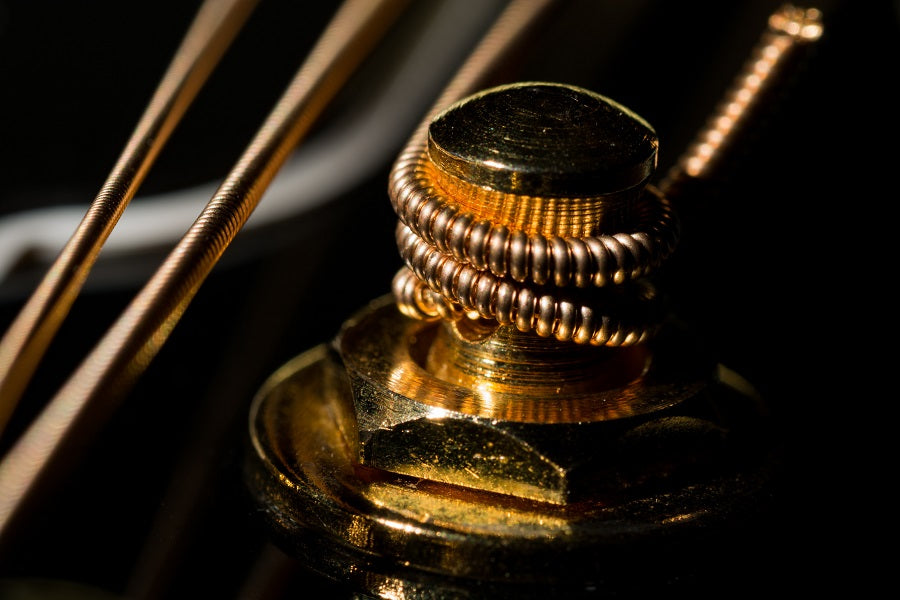
You will notice, the thickest guitar strings have a spiral wire wrapped-around, acting like a sanding file on the plectrum.
Guitar Pick Durability: How Long Should a Guitar Pick Last?
The short answer: If you are an average user, your picks should last a few weeks to a month. If you are a professional player, using specific techniques, like heavy picking and strumming, it will probably last just one day, especially if you are a studio musician recording new tracks every day.
The long answer: This answer includes many factors including guitar pick attributes, and external factors, regardless of the guitar pick you are using. We discuss all of them below.
Guitar Pick Attributes That Directly Affect the Durability
The attributes that define the durability of a guitar pick are as follows:
- Guitar Pick Material
- Guitar Pick Thickness
- Guitar Pick Tip Shape
- Guitar Pick Tip Texture
Harder materials will wear down slower. This is one of the reasons there has been a lot of research in the area of suitable materials for guitar picks.
The goal is to find a wear-resistant material, that keeps the tone characteristics that guitar players want, while still giving a good grip.
However, material is not all. The thickness of a guitar pick will enormously affect the wear and tear. Thinner picks will wear down almost immediately when using heavy pick techniques.

Other attributes of the pick that affect the durability, are the Tip Shape, and the Tip Texture. Very pointed guitar tips tend to wear down faster, because there is less material on the tip.
However, this problem can be partially solved with the right guitar pick tip texture. A polished tip on the guitar pick will cause less friction between strings and plectrum. This is one of the most underrated attributes of a guitar pick, and you can find more information HERE.
What Damages the Pick the Most?
Results show, that the best way of altering and degrading the shape of your plectrums is to perform “pick slides”.
This guitar technique will wear away the edges of your plectrum and will make it useless very quickly.
This won’t directly affect the tone or control of the plectrum, but the damaged sides will contain some dents. The plectrum will get stuck either on the up stroke or the down stroke.
External Factors Which Indirectly Affect the Durability
It’s not only the guitar pick quality that is responsible for its‘ damage. There are three more factors that can play a role on the durability:
- Hours of guitar training
- Guitar strings gauge
- Guitar playing style and used techniques
It is a very simple equation: The more hours you practice, the more your picks will get damaged.
Thicker guitar strings will increase the area of contact with your plectrum, and therefore, wear it down much faster.
Aggressive guitar playing techniques, like fast palm mute, or pick slides, will damage your guitar pick very easily.

How to know if a Pick is Durable?
The best way to find out, is to test it, and make your own judgment.
You can take advice of expert players, who have tested lots of guitar picks. However, if their playing styles differ from yours, this information won’t help much.
Besides, many expert players have not changed their picks for decades, and they might be missing the material improvements of the last decade.
As mentioned, not only is durability a factor to take into account when choosing a guitar pick, but also the tone and the ergonomics (grip, size,...).
How to Know When to Replace Your Pick?
If the edges of your pick are becoming more rounded, you might start to consider purchasing a new one.
However, never throw away your worn-down guitar picks! The rounded edges can be used to create more mellow tones, and you might want these for some of your songs.
One of the most important things about playing the guitar, is to keep your mind open to new tones and styles. This is the reason some guitar picks have rounded tips even when they are new.

In addition, you can store your old guitar picks in a box. I wish I still had my first guitar pick, that I used, when I was learned to play guitar as a child. A guitar pick can be a beautiful piece of your past.
Check Your Pick Condition Regularly
A tip from my side, is to double check every guitar pick before going out on stage, or studio. A visual inspection is fine.
Always keep some unused plectrums aside. Considering plectrums are probably the least expensive gear of your complete guitar rig, constant wear and tear issues is not a thing you should worry about.

Choose your ideal Plectrum
Are you using the right pick? This is a question you should ask yourself every time you play a song.
Some players have their 5-favourites, depending on the style and type of guitar they want to play.
The most important factors when choosing the right plectrum for you hinges on….
- Material
- Shape
- Thickness
- Size
- Playing style
- Your personal preference
We created a guide that will help you find the right plectrum for you.
You can find it HERE.
Thank you!
The support we are getting from the guitar community makes us very happy!
We, (Carlos and Judith), are really doing our best to create the best guitar picks for you.
If you consider supporting a small family start-up, you can share this article and directly have an influence on our online visibility.
These small actions have helped us since January 2019, and we count on your support! :)

Thanks!

Guitar Pick Grip: Why Textures On Guitar Pick Surfaces Can Help Improve Your Playing Experience
The surface of a guitar pick is in direct contact with your fingers. You feel it when you hold your pick, and your guitar strings will touch the surfaces every time you play a chord or a guitar solo.
Textures on guitar picks define not only important things like grip, control, and friction between the strings and guitar pick, but also equally important details like comfort, pick noise, and design.

Why Should The Different Areas Of The Guitar Pick Have Different Texture Types?
The guitar pick consists of two areas: The hold area (body), and the attack area (tip).
Both areas have different requirements. Generally speaking, when combining the proper textures of these two areas, a guitar pick should offer:
- a comfortable surface to hold the pick securely
- a well-designed tip to promote precision

With this simple fact in mind, it seems logical to differentiate these two areas when it comes to choosing the texture of the guitar pick.
Guitar Pick Hold Area:
The body of the guitar pick is the part of the plectrum, which you use to hold it.The textures on the body will directly affect:
- the control of the guitar pick
- the grip of the guitar pick
- the comfort of the guitar pick
These three features are strictly connected and every guitar player will have a very subjective opinion of them.
Guitar Picks With Grippy Surface:
These are specifically designed guitar picks. These guitar picks won’t slip so easily and the texture on the hold area will provide the guitar player with enough grip.
Advantages Of Guitar Picks With Grippy Surfaces:
-
Control the position of the pick between your fingers: avoid rotation and pick slippage.
-
Hold the pick with less tension, which results in a better playing experience and less hand fatigue.
Common Types Of Grippy Guitar Picks:

-
Sandpaper grip: Maximum grip, very aggressive texture (uncomfortable for long playing sessions)
-
Raised geometries or logos: High grip, aggressive texture (can feel uncomfortable for long playing sessions).
-
Micro-nodules texture: Medium/High grip, comfortable texture (the micro-nodules fit between the grooves of your skin). Read more here.
-
Grip Holes: Medium Grip
-
Homemade guitar pick grip: Some players use tape or make scratches on the pick to create a custom experience.
It is up to you to find a balance between comfort and grip. Some players prefer non-sticky guitar picks, some others need the maximum grip available.
The best thing you can do is try all different textures and decide yourself, considering the playing style you have.
For guitar sessions for over 1 hour, I prefer comfort over the grip. Once you get used to the guitar pick and how it reacts after every impact, you appreciate the comfort more and the playing experience texture and design can give you.
Guitar Pick Attack Area:
The texture on the tip of the plectrum will have a direct influence on:- Durability
- Pick Noise
The texture on this guitar pick area is one of the most undiscovered features in the guitar pick world. Read more here.
How can a polished guitar pick improve durability and reduce noise?
Actually, it is very simple: A mirror polished guitar pick will reduce friction between guitar pick and strings. With every impact, the guitar pick will suffer less friction and therefore wear down slower.
With less friction, the pick will cause less pick noise. From my own experience, guitar picks with this attribute make me want to play forever.
In addition, the pick will glide better and provide a better playing experience. However, this is a very subjective point since other types of guitar picks with coarse textures on the tip are very popular amongst some guitarists. Pick noise is sometimes wanted when strumming chords.
Bonus Feature: Unique Designs:
This is a bonus argument I always use: Combining different textures in one pick can be very useful for creating unique designs.Guitar pick surfaces not only affect the function, but also the aesthetics.
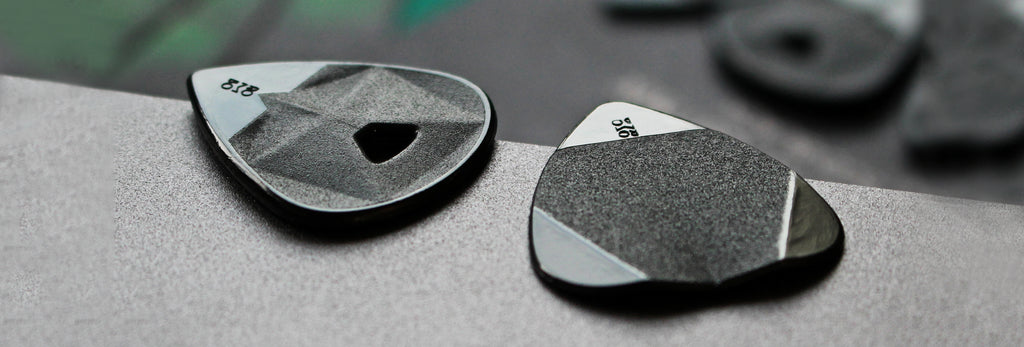
In order to build your own image, you need gear that fits in it. Design is as important as the other aspects when it comes to music gear.
Fortunately, we live in an era where many brands are creating very original designs with the best functionality.
Guitar Pick Grip: What Textures Are We Using At Rombo?
We believe textures on guitar picks are essential for a tool that was designed to be held between your fingers
The combination of two different surface finishes in the guitar picks have convinced us and our testers of the potential gains a player can achieve:
- A polished tip for clarity, durability and control
- A micro-nodules texture in the centre of the guitar pick for the most comfortable holding without compromising grip
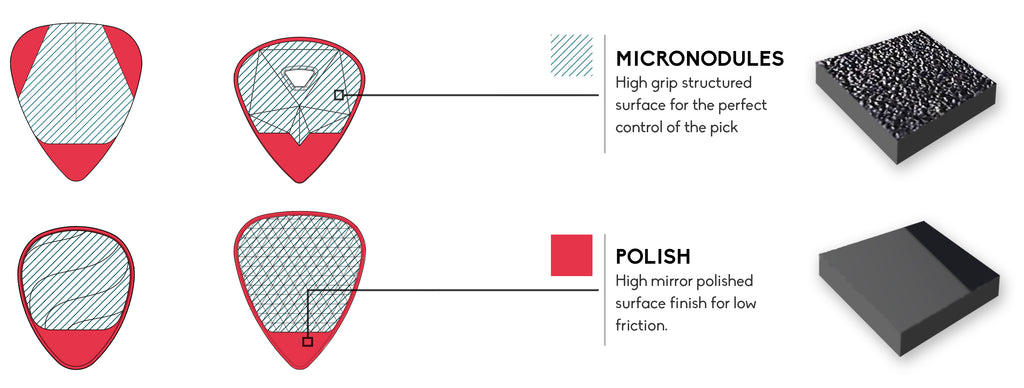
Conclusion:
Grippy textures can help you hold the guitar pick more firmly without effort.
Looking for a texture you feel comfortable with is essential to find the balance between grip and comfort.
However, what about thickness, shape, size, and material? Have you thought about these attributes?
Learn more in our article "How to choose the right guitar pick".
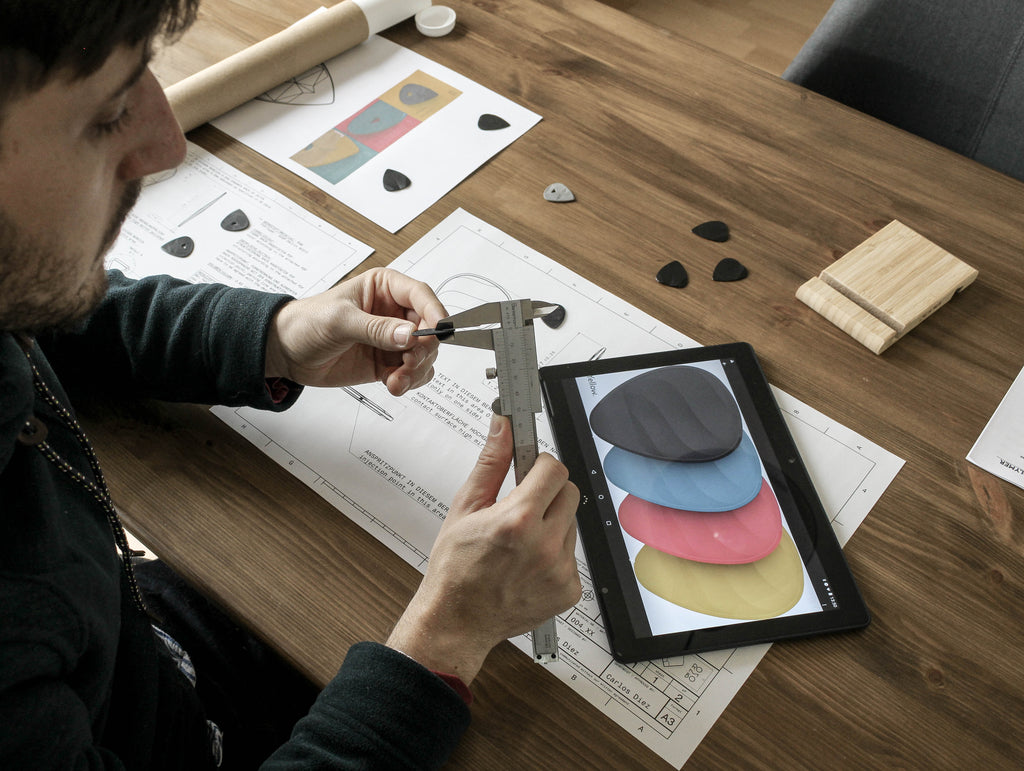

6 Underrated Features Of A Guitar pick
In our article “How to choose the right guitar pick”, I summarized the aspects you should care about and consider when deciding which plectrum to use.
In this article, we will discuss the characteristics of a guitar pick we must pay attention to in order to make the playing experience much more comfortable and obtain better results. These aspects are not as obvious as others but are essential to get the most out of this incredible musical instrument.

1- Guitar Picks with Micronodules Grip Structure:
Grippy, non-sticky surfaces are perfect for the hold area on a guitar pick. The best way to achieve this is to create a texture, that fits between the grooves of your skin and prevents the guitar pick from slipping or creating an aggressive grip geometry that hurts the fingers of the guitarist.

2- High Mirror Polished Tip:
A guitar pick with a polished tip allows you to experience better control and less friction. In this way, reduced friction between the plectrum and the strings of the guitar will help increase the durability of the pick because it will wear less and reduce its noise.

3- Variable Thickness:
One of the less common characteristics in guitar picks is variable thickness. It is ideal for the guitar pick to be thick for better control; however, this could significantly reduce its flexibility.
For that reason, plectrums of variable thickness have been created, since this would give us the best of both aspects.
That is to say, we could have a guitar pick with a solid, thick body that gives us better grip. Additionally, it features a thinner tip that provides enough flexibility to achieve greater versatility when developing different guitar techniques.

Read more about the advantages of using a guitar pick with variable thickness in our article "5 advantages of a guitar pick with variable thickness"
4- Ergonomic Design Surfaces:
By following ergonomic models, the surface of the pick can be adapted to be comfortable, provide well-being and does not hurt the guitarist's fingers. It is advisable to look for picks with a 3D surface (those that are not flat) that have geometric patterns that offer a pleasant feeling to the grip. Similarly, we can take advantage of concave or convex surfaces, as they help keep the position of the plectrum oriented and avoid losing control in turning movements.
5- High-quality materials:
If your hands do an arduous job, then you must give them the right tools, right? Many people spend a lot of money on fancy guitars, cables, amplifiers, and other accessories but set aside the pick. This is a big mistake.
The material with which it is made can influence the definition of tone, attack, and flexibility. Therefore, without paying attention to it, you could hardly find your personal sound.
Are you curious about the materials used for the Rombo guitar picks?
Read a full article about it here:
https://rombopicks.com/blogs/insight-rombo/guitar-pick-materials-at-rombo
6- Unique Designs:
If you want to project an image with your own style, you must pay close attention to the design of your implements. To do this, you can try all the shapes and colors of guitar picks available in the market. Just imagine having one with an incredible appearance that is also very functional.

Conclusion:
In short, all aspects are subjective and depend on each person. Nevertheless, knowing such valuable information can expand our possibilities and options to choose the guitar pick that best suits our needs.
Tell us if you think this data can help you during the learning process of playing guitar and let us know if there are any other details about guitar picks that you think we should consider.
PS: Remember, you should share your skills with the world. In the article, “MUSIC AND DIY GENERATION”, I explain how the Internet community of guitarists helped me understand the importance of sharing my work.
- Shop
- Dealers
- Legal Notice
- Terms of Service
- Refund Policy
- Shipping
- Privacy Policy
- Contact us
- Press
- FAQ
Sign up to get the latest on sales, new releases and more…
By signing up you agree to our privacy policy.
© 2024 ROMBO.
registered brand
Powered by Shopify


